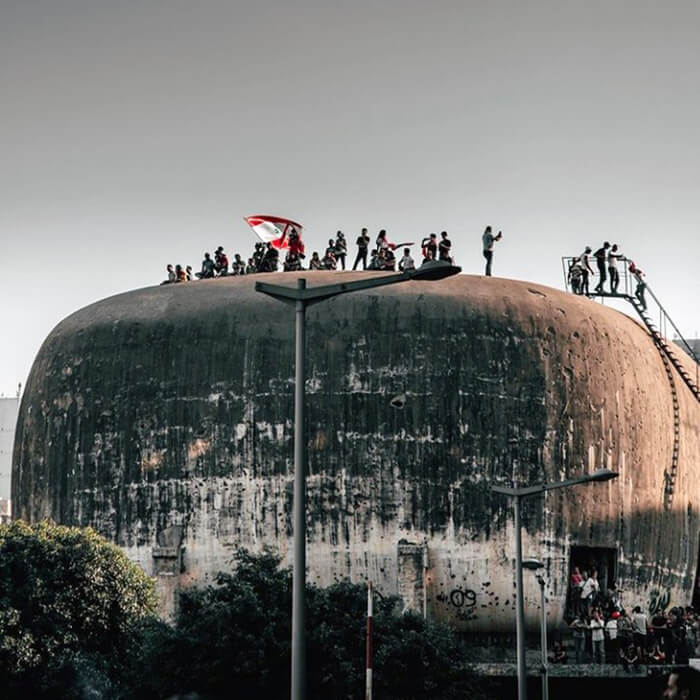Society
12.26.2019
“The egg” of Beyrouth: From abandoned building to revolutionary symbol

In Lebanon, an abandoned building has become a symbol of the revolution. Called “The egg” because of its oval architecture, it was invaded by protesters and street artists who have coated its walls with revolutionary graffiti and slogans since the protests began on October 17, 2019.
Built in the 1960s, the so-called “The egg” or the Beirut dome is an architectural project led by Lebanese architect Joseph Philippe Karam and engineer Georges Tabet. Originally, It was part of a multicultural complex consisting of two towers, supposed to house a cinema, a parking, as well as the largest shopping center in the Middle East. Left out at the start of the civil war in 1975, it has since oscillated between several failed restoration projects which should have been carried out by Bernard Khoury (2004), and Christian de Portzamparc (2011). Defended by several activists like Aimé Merheb who signed the documentary “Save the egg” in 2010, it is today considered as an integral part of the Lebanese civil war heritage, an importance confirmed by the revolution.
A revolutionary symbol
Between the Al-Amine mosque near the Martyrs square in downtown Beirut, and the famous “ring”, a road that connects the East and West part of the city, lies the dome of Beirut. A massive block of gray concrete located next to a disused parking, it rests there like a forgotten rock, invincible to the ravages of time.
Invaded by the demonstrators since the beginning of the revolution, the structure seems to rise from the ashes. From its first days, the dilapidated building turned into a bastion of protestors of all ages and all faiths. On Instagram, many pictures displayed a scene where people were seen escalating and standing on its roof, in what they call “Lebanon rises”, as a poetic metaphor for an ascent to a better future.

The Lebanese street artists also wanted to add their personal touch to this iconic building. In front of its facade, a large fresco has been made by several famous graffiti artists in Beirut, including EPS, Exist and Spaz, Meuh, Moe, nush, Barok, Quetz, Fish. We can observe the “face” of the revolution, a man with two red lines on the cheeks, next to a graffiti artist’s head. Right next to it is a satirical drawing of a rat with a piece of cheese, an obvious analogy with the members of the Lebanese government who devour the country’s resources. But also many slogans of hope and in the name of thwara (revolution in Arabic).
Reclaiming public space by the people
From morning to night, Lebanese but also curious tourists wander around the building to take pictures or selfies of the graffitis that adorn the structure, like this Italian who came in Lebanon for vacation “I did not know that this place was an old cinema but it’s nice to see how it has been transformed by street artists ”.

The company Alternative Tour in Lebanon, which offers weekly tours of Beirut, also brings tourists to this icon of the revolution. “Since the start of the protests, The egg has been transformed into a multicultural stronghold, regularly hosting conferences, discussions, film screenings but also techno evenings.” explains the Aya guide to attentive visitors.
Proof that the revolution has not only served to rehabilitate a forgotten place, it also gave the opportunity to Lebanese people to reclaim public place, which the Lebanese capital definitely lacks because of the growth of wild real estate projects, especially on the coastline.
As Jana says “I am very happy that the people are rediscovering this architectural gem and have taken it back, even if I find it a little dangerous to see crowds mobilize on the roof as the building threatens to collapse”.
popular

